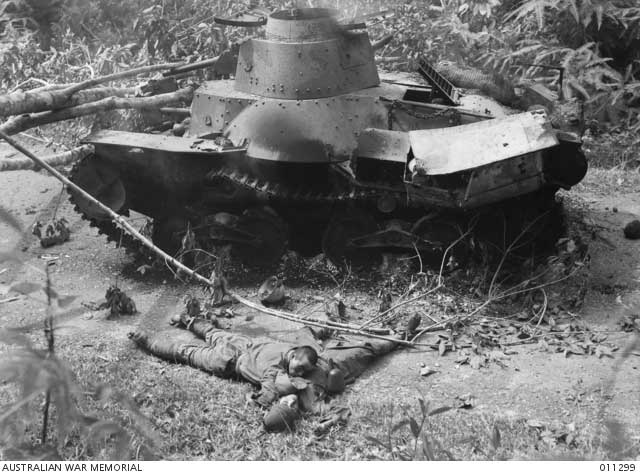Friday 5 December 1941
 |
| As originally published, this photo had the following caption: "Boy gunner of Soviet armored car: A boy gunner of a Soviet armored car peers from the turret during the occupation of Teheran, Iran." The photograph is dated December 5, 1941. Iran is extremely important as a route for Allied Lend-Lease supplies to Russia that the Axis cannot stop. |
Eastern Front: Following a night of frigid weather that sees temperatures hit -25 °F, on the morning of
5 December 1941 the Soviet forces of 29th Army counterattack the most advanced German positions at Kalinin. Advancing across the frozen Volga River, they break into the German Ninth Army lines west of Kalinin. The German Third Panzer Army (General Hoepner) attempts to counterattack in turn at Krasnaya Polyana and Moscow-Volga Canal, but it gets nowhere because much of the equipment is frozen and must be called back.
 |
| A Soviet propaganda shot of a wrecked German column destroyed on the Volokolamsk Highway in the opening thrust of the Moscow counteroffensive on 5 December 1941 (Russian International News Agency). |
This is the opening stage of the grand counteroffensive proposed on 30 November by Soviet General Georgy Zhukov. Other fronts remain normal, and at Tula south of Moscow, General Guderian continues attacking. However, as the day shows massive Soviet troop concentrations right behind the front, Guderian has a change of heart. As he later writes in his memoirs:
On account of the threats to our flanks and rear and of the immobility of our troops due to the abnormal cold, I made the decision during the night of December 5-6 to break off this unsupported attack and to withdraw my foremost units into defensive positions along the general [river line] Upper Don-Shat-Upa. This was the first time during the war that I had to make a decision of this sort, and none was more difficult.
It is unclear if the Second Panzer Army even has the ability to completely evacuate its salient at Tula and retreat to the Don and Shat rivers. It has exposed forces well to the east of Tula that will have to make good their escape quickly if they want to see Germany again.
 |
| Royal Navy submarine HMS Sealion torpedoes and sinks 638-ton Norwegian freighter Island (shown) in Vestifjord off northern Norway on 5 December 1941. |
The Soviets are preparing to expand the offensive on 6 December. The Stavka sends orders today to the West Front armies to join in then. However, the objective is not to chase the Germans out of Russia. Instead, it is just to get a little breathing room around Moscow. At First Shock Army, for instance, General Kuznetsov is ordered simply to clear an area around Dednevo and Fedorovka while "in the longer run" preparing an advance "in the direction of Klin." The West Front as a whole is exhorted to unleash "blows" on the Germans and to "smash" their flanks. It is very cold for both sides. Which side has a numerical advantage at this point is unclear and that question never is resolved to everyone's satisfaction (boosters of each side forever insist that the other has the advantage). However, the key difference is that the Germans are not used to these extreme conditions, whereas the Soviets grew up in them, designed their weapons systems and supply trains around them, and have advantages such as undamaged rear areas and the glory of fighting for their homeland. What is clear is that the Germans suddenly realize that things have changed for their forces, and definitely not for the better. Operation Typhoon is over.
 |
| HMAS Yarra, shown above in August 1941, and HMS Flamingo are bombed and damaged on 5 December 1941 as they attempt to resupply embattled Tobruk. Yarra suffers only minor damage from near misses, while Flamingo has to be towed into the port (Australian Navy). |
Battle of the Mediterranean: General Rommel senses a developing victory over the British Eighth Army on 5 December 1941. He has turned the British Operation Crusader into a confusing mess where the bulk of the British forces have had to retreat toward the Egyptian border. The Afrika Korps panzers, however, are strung out in exposed positions with tenuous supply lines, but they still pack a powerful punch. Today, when the 11th Indian Brigade attacks an Italian Young Fascist garrison, it has some success during the day. However, at dusk, the panzers of the 15th Panzer Division, combined with the Italian Ariete armored forces, strike back. They route the Indian troops, which has to be withdrawn and replaced by the 22nd Guards Brigade overnight. After this success, German General Crüwell withdraws his forces to the west due to fear of a British armored riposte and thereby cedes valuable and hard-won ground.
 |
| German soldiers with a captured Soviet KV-2 tank near Pulkovo, Leningrad on 5 December 1941. The Germans have put a little flag, not the typical Balkenkreuz but a reasonable facsimile, on the tank in order to use it themselves as a Beutepanzer. |
Japanese Military: The Japanese carrier strike force, Kido Butai, continues its journey east toward Hawaii. Other Japanese forces board transports and head south from China heading for Malaya. Seven more troop transport ships leave Saigon in French Indochina and rendezvous with the troop transports coming down from China, swelling the invasion force with seasoned soldiers of the 56th Division. Japanese destroyer Uranami comes across an unsuspecting Norwegian freighter, 1515-ton MV Halldor, about five miles off Saigon and the Japanese board it, smashing its radio. The Norwegians then are released to proceed willingly to Hong Kong, where the Japanese later seize the ship.
 |
| The Kawanishi E15K Shiun makes its maiden flight on 5 December 1941. It has some issues with its novel retractable stabilizing floats which never are solved. Only 15 are completed during the war, including six prototypes. |
Conducting a war across the vast stretches of the Pacific Ocean requires constant reconnaissance, and the most efficient way to achieve that is with floatplanes and flying boats that can land at isolated spots, refuel, and continue their patrols. Today, the Imperial Japanese Air Force makes the first flight of the Kawanishi E15K Shiun was a single-engined Japanese reconnaissance floatplane. The Allies will give this the reporting name "Norm," named in honor of Squadron Leader Norman O. Clappison of the RAAF, a member of the Allied Technical Air Intelligence Unit (ATAIU) who first spots it.
 |
| Amrita Sher-Gil, a renowned Hungarian-Indian painter who passes away mysteriously at age 28 on 5 December 1941 in Lahore, India (later Pakistan). |
December 1941December 1, 1941: Hitler Fires von RundstedtDecember 2, 1941: Climb Mount NiitakaDecember 3, 1941: Hints of Trouble in the PacificDecember 4, 1941: Soviets Plan CounteroffensiveDecember 5, 1941: Soviets Counterattack at KalininDecember 6, 1941: Soviet Counterattack at Moscow BroadensDecember 7, 1941: Japan Attacks Pearl HarborDecember 8, 1941: US Enters World War IIDecember 9, 1941: German Retreat At MoscowDecember 10, 1941: HMS Prince of Wales and Repulse SunkDecember 11, 1941: Hitler Declares War on the USDecember 12, 1941: Japanese in BurmaDecember 13, 1941: Battle of Cape BonDecember 14, 1941: Hitler Forbids WithdrawalsDecember 15, 1941: The Liepaja MassacreDecember 16, 1941: Japan Invades BorneoDecember 17, 1941: US Military ShakeupDecember 18, 1941: Hitler Lays Down the LawDecember 19, 1941: Brauchitsch Goes HomeDecember 20, 1941: Flying Tigers in ActionDecember 21, 1941: The Bogdanovka MassacreDecember 22, 1941: Major Japanese Landings North of ManilaDecember 23, 1941: Wake Island Falls to JapanDecember 24, 1941: Atrocities in Hong KongDecember 25, 1941: Japan Takes Hong KongDecember 26, 1941: Soviets Land in the CrimeaDecember 27, 1941: Commandos Raid NorwayDecember 28, 1941: Operation Anthropoid BeginsDecember 29, 1941: Soviet Landings at FeodosiaDecember 30, 1941: Race for BataanDecember 31, 1941: Nimitz in Charge2020



















